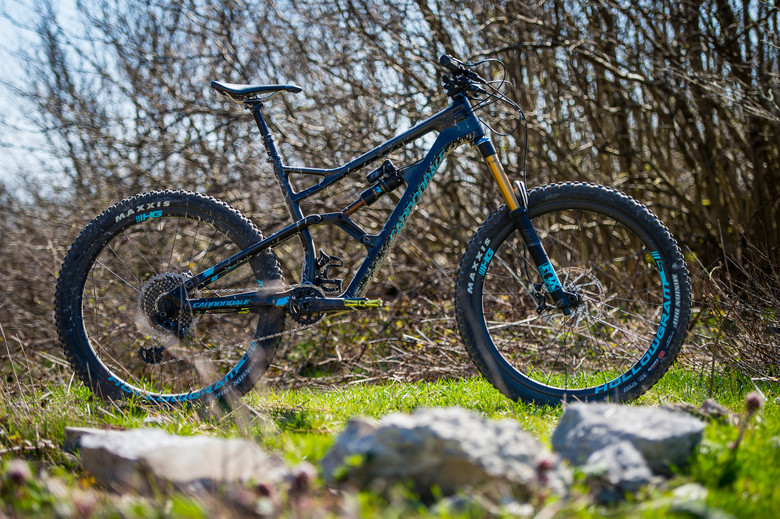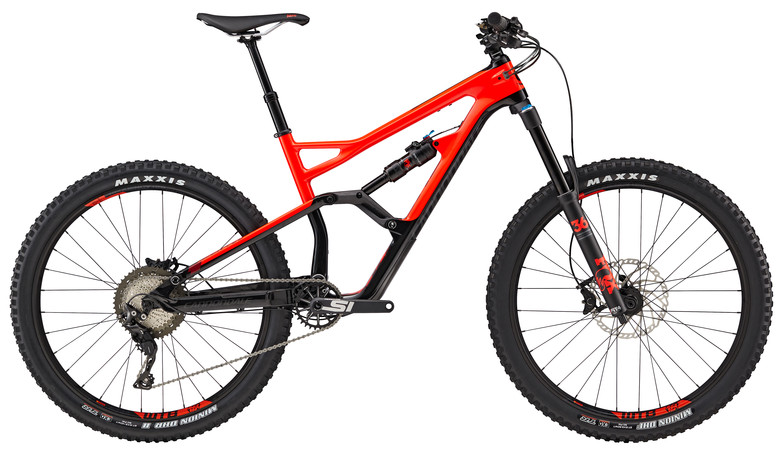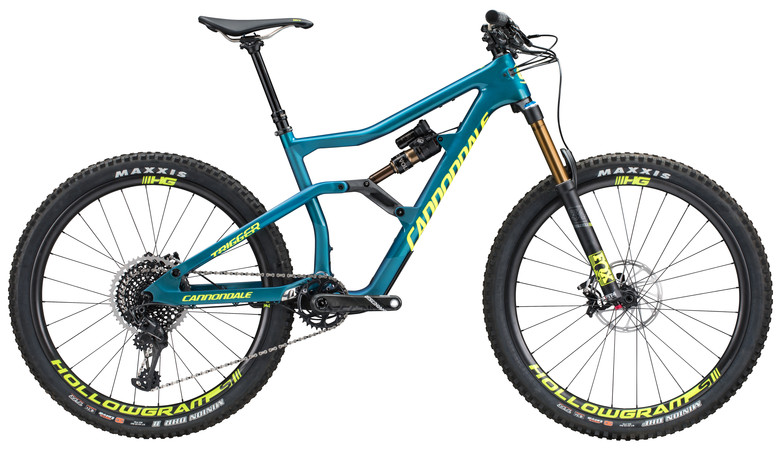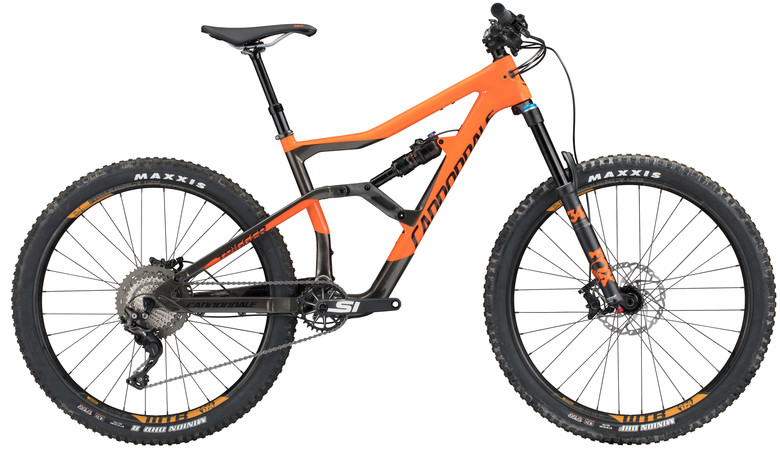You’ve heard it all before, modern enduro bikes need to climb like a goat and descend like a bat straight out of hell. While this tired old phrase is easy to dismiss as just another empty statement from the marketing crew, the truth is that every brand has their own idea of exactly how to produce this elusive blend of efficiency and shred-ability. Cannondale has long been a proponent of a split personality approach to the problem, but some of their previous attempts have fallen short of delivering on the promise. The 2017 edition of the Jekyll and Trigger bikes are out to change all that, with a more standardized approach that retains the basic Cannondale philosophy, while still delivering flick-of-the-switch suspension changes that effectively combine two versions of the same bike into one. We headed down to sunny Finale Ligure to get to know the new bikes in this most enduro of locations.

2017 Cannondale Jekyll Highlights | 2017 Cannondale Trigger Highlights |
|
|
Introduction
Cannondale has known success at the enduro races with its Jekyll, notably under EWS champion Jerome Clementz. However, the company struggled a bit to turn race results into mass appeal for its innovative but also ultra-proprietary bike. With a pull-shock design and a Lefty “SuperMax” fork on the high-end models, with the current Jekyll or Trigger you had to commit to a lot of non-standard tech. When redesigning the range for 2017, Cannondale wanted to take a more mainstream approach while still retaining the dual-personality approach of the current models.
This is not just about climbing, but about offering a “built-in” short travel experience in your long-travel bike.


Rather than try to come up with a linkage design that pedals as well as it descends (always a compromise), Cannondale wanted a system that would allow you to change the behavior of the bike at the press of a button. Their objective here is to offer the best performance on the downhills, with as little compromise as possible, and a little extra help where needed on flatter trails that require more pedaling. This is not just about climbing, but about offering a “built-in” short travel experience in your long-travel bike. The current versions of the Jekyll and Trigger rely on a custom, proprietary pull-shock, which reduces the travel (drastically) and changes the spring rates on the fly. For the 2017 model, Cannondale took a different approach. Starting from a standard, shock configuration, they worked with FOX to come up with a clever, dual air chamber design that lets you close off one of the chambers with a handlebar-mounted remote lever – the concept is called “Gemini” and the two modes “Hustle and Flow”.

This system creates a shock that literally cannot be fully compressed when in “Hustle” mode, reducing the bike’s rear travel and creating a more progressive spring rate. A flick of the lever, you open the system back up and you’re left with all the performance and adjustability of a standard FOX shock. As a side note, if you are less interested in the travel reducing feature, you can swap the shock out for any compatible option, based on standard metric shock sizing. Additionally, gone from the line-up are the Lefty forks as they were simply not “what riders in this category were looking for”. Finally, Cannondale stuck with its tried and true single-pivot layout, as they feel that after so many years of using it, they know how to tune it and they can achieve all their design goals without needing to resort to any other approach.

As previously mentioned, Gemini is about more than a providing a climbing crutch. It’s meant to deliver a poppier, snappier ride for all those trails where you might want to get some extra pedals in (*cough* racing *cough*), pump the trail for speed, or play around on smaller trail features. It’s also designed to leave the suspension active enough in short travel mode for rougher, more technical climbs (a shortcoming of the previous generation Jekyll/Trigger). Of course, shorter travel and a more progressive spring rate translate to less bobbing for those long fire road grinds as well, but the shock itself can do one better here: since Gemini is based around standard FOX shocks, you also retain any trail mode/lockout features the shock itself may offer (depending on the spec you choose).


Aside from the work on the new shock, Cannondale took the opportunity to bring the geometries of its new trail and enduro bikes up to modern standards. Longer reach, slacked-out head angles, and super short chainstays that maintain a lively rear end were the stated goals. The 165-mm travel Jekyll was designed around a 35mm stem, and it was given a healthy dose of extra reach as well as a very aggressive 65-degree head angle to deal with the demands of any modern enduro stage. The 145-mm travel Trigger follows not too far behind, with a 66-degree head angle and the same, super-short chainstays, although this bike was designed around a 45mm stem to put a bit more weight over the front tire for climbing.

It sounds complicated but in reality, with what passes for standards these days, you might as well take it to the extreme if you have a good reason for doing so.
Cannondale went with 27.5” wheels both for the long travel Jekyll and the shorter travel Trigger, as they felt this size was best suited to their design goals of a stable yet nimble, fun-loving bike. To be able to run super short, 420mm chain stays yet offer enough clearance for a meaty tire or a muddy day, Cannondale came up with “Ai” – or “Asymmetric Integration”. In short, it’s an adaptation of the Boost standard, with a little extra offset, using a standard chainring but an 83mm spindle, and a 148x12 rear axle with extra offset for a dishless wheelbuild. It sounds complicated but in reality, with what passes for standards these days, you might as well take it to the extreme if you have a good reason for doing so. You can even still squeeze a front derailleur in here if you're so inclined.


The frame features fully internal cable routing with guides to make wrenching easier, and there’s a clever set of “chips” to allow you to configure the cable entry and exit ports as needed. The carbon downtube protector is a nice touch, and both the Jekyll and the Trigger can carry a water bottle in the frame (albeit a slightly smaller one on the Jekyll). Also note that that all the models get the same carbon rocker link, as Cannondale felt it offers the best stiffness to weight ratio and that they did not need to skimp on this particular item to meet the pricing goals of the lower end models.

On The Trail
Finale Ligure shot to fame during the inaugural season of the Enduro World Series, when it hosted the series finale (!) and showed the world just how good riding your bike around this quiet little Italian seaside town can be. It’s been a fixture on the EWS calendar ever since, and with good reason: with everything from flow trails to high alpine, exposed rock fests on the menu, the riding here is as enduro as it gets (and of course, there’s the gelato…). The town welcomes bikers with open arms (the local shuttle companies and hotels even co-fund two full-time trail builders to keep their stash of trails in good condition), and we wasted little time making the most of their hospitality.

We started out riding the new Jekyll, and we made the most of the shuttles on offer to put in some serious descending on this capable machine. From the first turns, the Jekyll was easy to get along with. The roomy reach, wide bars and short stem put us in attacking mode right away, and the Jekyll happily went along with whatever the trail put in our path. As we previously alluded to, Cannondale favored a very neutral rear linkage layout with regards to anti-squat and chain growth, the idea being to leave the suspension free to move without interference from pedal-induced forces on the chain. This also means the Jekyll is a bit prone to bobbing, and although it's not sluggish per se it also doesn't sprint with the best of them. This is where that “Hustle” mode comes in handy…



Flipping the Gemini lever does two things: reduces travel and increases the progressiveness of the spring rate. This translates to a much livelier rear end, but it is not a lock out – the shock retains all of its functionality, just in shorter travel mode. This leaves you sitting higher in the travel, and the ride becomes far more responsive. The idea is to use the “Hustle” mode to carry speed and make the most of less demanding trails, while the “Flow” mode is there when things get proper gnarly. We found the system effective and easy to use, although the lever itself is a bit awkward to reach (it’s hard to see how to improve on it though, since it has to coexist with the brakes and your dropper post or shifter levers). Analyzing the ride qualities of the new frame, the new Jekyll is very stiff - likely due in part to Cannondale's "LockR" thru-axle pivot system but also the general construction of the carbon frame. Coupled with the carbon wheels of our test bike the result is a stiff and responsive ride. We had no trouble finding grip, but the bike is certainly on the more rigid side of the equation.


The rear linkage is progressive enough to deal with bigger hits, but without taking it too far. We were particularly impressed with how the bike dealt with fast and rough trails, making small and medium sized hits all but disappear under the wheels at speed. The bike only starts to hang up a bit on bigger stuff, when the super short stays and a main pivot placement optimized for a 30T chainring make themselves known. On the topic of those short stays, they certainly help make the Jekyll more playful, while the long reach and wheelbase kept it from ever feeling twitchy.

All in all, the Jekyll was predictable and confidence inspiring, which helped us deal with discovering the rough and tumble trails of Finale Ligure for the first time. Cannondale’s wild man of enduro Mark Weir doesn’t need any help but he certainly took to his task with joy. He was instrumental in the bike’s design along with his team mates Marco Osborne and Jerome Clementz.

Day two and after a brief presentation on the beach we headed to the trails on the new Trigger. We started the day with a 40-minute road climb, where apart from blowing out our legs trying to take on Mark Weir in a sprint we were also able to appreciate the light weight and snappier pedal response of the 145mm bike we were now on. At just 12.2kg for the all-carbon Trigger 1, and equipped with SRAM’s excellent Eagle transmission, there are no real limits for what you can hoist yourself up except for your own strength and stamina. Our chosen route also took in some pretty steep and rough climbs, where we found the “Hustle” mode and its 115mm of snappy travel to be just the ticket.



Just like on big brother Jekyll, the Trigger exhibits a fair amount of pedal bob both in Hustle and Flow mode, but a quick flick of the compression lever on the FOX Float X shock all but removes that issue from the equation.

Point the Trigger down the hill, and you’re reminded that you are still riding a very capable trail bike. With 150mm of travel from the excellent FOX Float 34 Factory up front, it’s only when the trail gets really rough that you start to feel the limits of the bike holding you back (compared to the Jekyll, specifically). With a 66-degree head angle, the Trigger is not far behind many an enduro rig, and although the reach is reined in compared to the Jekyll, the Trigger still offers plenty of room to move around and a confidence inspiring stance. Flip the switch to Hustle mode, and it’s positively snappy. Two bikes in one, as intended.

So, how to choose between the two? The Jekyll frame tips the scales at a mere 300 grams more than the Trigger, and at the top end of the builds, there is not that much more to set them apart in total weight either. Both bikes offer a good climbing position, in particular the Jekyll impressed us here with its 75-degree seat tube angle. Both bikes are very capable descenders, with the Trigger holding a slight advantage on flatter or more pedally trails and the Jekyll pulling ahead when the going gets properly rowdy. On paper, we'd argue that most riders would probably get more out of the Trigger, with its snappier feel and ability to pump speed from any trail, and we’re not against the idea of getting as little bike as you can get away with these days to increase your fun factor. However, the “Hustle and Flow” concept is very well executed on the Jekyll, and the fact that you get two bikes in one means you can easily live with it as a “daily driver” too. Which makes this beast of a bike all that more tempting…because, why not?
Geometry


2017 Cannondale Jekyll Build Kits and Pricing








2017 Cannondale Trigger Build Kits and Pricing
Trigger 1


Trigger 2

Trigger 3

Women's Trigger

The new bikes are available now. For more information, head on over to www.cannondale.com.
Words by Johan Hjord // Photos by Johan Hjord / Cannondale (Ale Di Lullo - Mondini)







View replies to: Hustle and Flow: 2017 Cannondale Jekyll and Trigger
Comments